TorchVision Object Detection Finetuning Tutorial¶
Tip
To get the most of this tutorial, we suggest using this Colab Version. This will allow you to experiment with the information presented below.
For this tutorial, we will be finetuning a pre-trained Mask R-CNN model on the Penn-Fudan Database for Pedestrian Detection and Segmentation. It contains 170 images with 345 instances of pedestrians, and we will use it to illustrate how to use the new features in torchvision in order to train an object detection and instance segmentation model on a custom dataset.
Note
This tutorial works only with torchvision version >=0.16 or nightly. If you’re using torchvision<=0.15, please follow this tutorial instead.
Defining the Dataset¶
The reference scripts for training object detection, instance
segmentation and person keypoint detection allows for easily supporting
adding new custom datasets. The dataset should inherit from the standard
torch.utils.data.Dataset class, and implement __len__ and
__getitem__.
The only specificity that we require is that the dataset __getitem__
should return a tuple:
image:
torchvision.tv_tensors.Imageof shape[3, H, W], a pure tensor, or a PIL Image of size(H, W)target: a dict containing the following fields
boxes,torchvision.tv_tensors.BoundingBoxesof shape[N, 4]:the coordinates of the
Nbounding boxes in[x0, y0, x1, y1]format, ranging from0toWand0toH
labels, integertorch.Tensorof shape[N]: the label for each bounding box.0represents always the background class.
image_id, int: an image identifier. It should beunique between all the images in the dataset, and is used during evaluation
area, floattorch.Tensorof shape[N]: the area of the bounding box. This is usedduring evaluation with the COCO metric, to separate the metric scores between small, medium and large boxes.
iscrowd, uint8torch.Tensorof shape[N]: instances withiscrowd=Truewill beignored during evaluation.
- (optionally)
masks,torchvision.tv_tensors.Maskof shape[N, H, W]: the segmentation masks for each one of the objects
- (optionally)
If your dataset is compliant with above requirements then it will work for both
training and evaluation codes from the reference script. Evaluation code will use scripts from
pycocotools which can be installed with pip install pycocotools.
Note
For Windows, please install pycocotools from gautamchitnis with command
pip install git+https://github.com/gautamchitnis/cocoapi.git@cocodataset-master#subdirectory=PythonAPI
One note on the labels. The model considers class 0 as background. If your dataset does not contain the background class,
you should not have 0 in your labels. For example, assuming you have just two classes, cat and dog, you can
define 1 (not 0) to represent cats and 2 to represent dogs. So, for instance, if one of the images has both
classes, your labels tensor should look like [1, 2].
Additionally, if you want to use aspect ratio grouping during training
(so that each batch only contains images with similar aspect ratios),
then it is recommended to also implement a get_height_and_width
method, which returns the height and the width of the image. If this
method is not provided, we query all elements of the dataset via
__getitem__ , which loads the image in memory and is slower than if
a custom method is provided.
Writing a custom dataset for PennFudan¶
Let’s write a dataset for the PennFudan dataset. After downloading and extracting the zip file, we have the following folder structure:
PennFudanPed/
PedMasks/
FudanPed00001_mask.png
FudanPed00002_mask.png
FudanPed00003_mask.png
FudanPed00004_mask.png
...
PNGImages/
FudanPed00001.png
FudanPed00002.png
FudanPed00003.png
FudanPed00004.png
Here is one example of a pair of images and segmentation masks
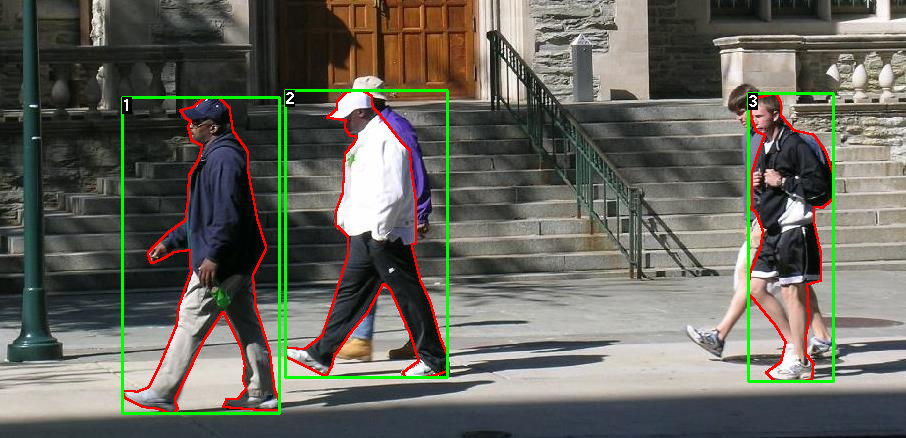
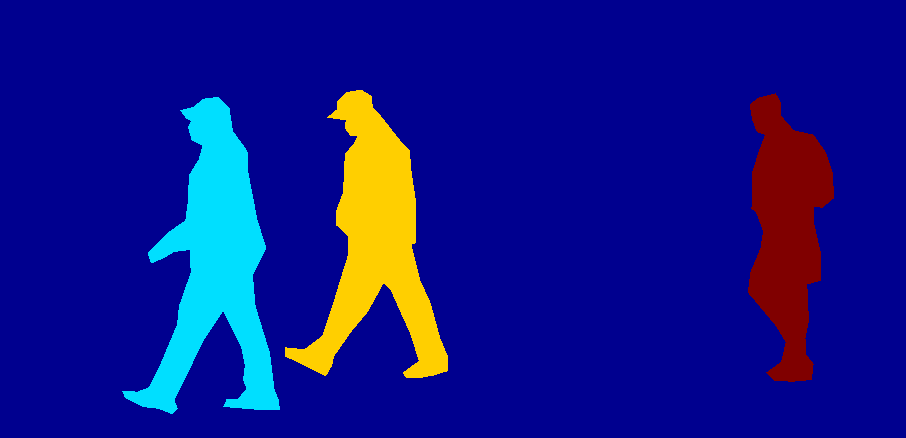
So each image has a corresponding
segmentation mask, where each color correspond to a different instance.
Let’s write a torch.utils.data.Dataset class for this dataset.
In the code below, we are wrapping images, bounding boxes and masks into
torchvision.TVTensor classes so that we will be able to apply torchvision
built-in transformations (new Transforms API)
for the given object detection and segmentation task.
Namely, image tensors will be wrapped by torchvision.tv_tensors.Image, bounding boxes into
torchvision.tv_tensors.BoundingBoxes and masks into torchvision.tv_tensors.Mask.
As torchvision.TVTensor are torch.Tensor subclasses, wrapped objects are also tensors and inherit the plain
torch.Tensor API. For more information about torchvision tv_tensors see
this documentation.
import os
import torch
from torchvision.io import read_image
from torchvision.ops.boxes import masks_to_boxes
from torchvision import tv_tensors
from torchvision.transforms.v2 import functional as F
class PennFudanDataset(torch.utils.data.Dataset):
def __init__(self, root, transforms):
self.root = root
self.transforms = transforms
# load all image files, sorting them to
# ensure that they are aligned
self.imgs = list(sorted(os.listdir(os.path.join(root, "PNGImages"))))
self.masks = list(sorted(os.listdir(os.path.join(root, "PedMasks"))))
def __getitem__(self, idx):
# load images and masks
img_path = os.path.join(self.root, "PNGImages", self.imgs[idx])
mask_path = os.path.join(self.root, "PedMasks", self.masks[idx])
img = read_image(img_path)
mask = read_image(mask_path)
# instances are encoded as different colors
obj_ids = torch.unique(mask)
# first id is the background, so remove it
obj_ids = obj_ids[1:]
num_objs = len(obj_ids)
# split the color-encoded mask into a set
# of binary masks
masks = (mask == obj_ids[:, None, None]).to(dtype=torch.uint8)
# get bounding box coordinates for each mask
boxes = masks_to_boxes(masks)
# there is only one class
labels = torch.ones((num_objs,), dtype=torch.int64)
image_id = idx
area = (boxes[:, 3] - boxes[:, 1]) * (boxes[:, 2] - boxes[:, 0])
# suppose all instances are not crowd
iscrowd = torch.zeros((num_objs,), dtype=torch.int64)
# Wrap sample and targets into torchvision tv_tensors:
img = tv_tensors.Image(img)
target = {}
target["boxes"] = tv_tensors.BoundingBoxes(boxes, format="XYXY", canvas_size=F.get_size(img))
target["masks"] = tv_tensors.Mask(masks)
target["labels"] = labels
target["image_id"] = image_id
target["area"] = area
target["iscrowd"] = iscrowd
if self.transforms is not None:
img, target = self.transforms(img, target)
return img, target
def __len__(self):
return len(self.imgs)
That’s all for the dataset. Now let’s define a model that can perform predictions on this dataset.
Defining your model¶
In this tutorial, we will be using Mask R-CNN, which is based on top of Faster R-CNN. Faster R-CNN is a model that predicts both bounding boxes and class scores for potential objects in the image.
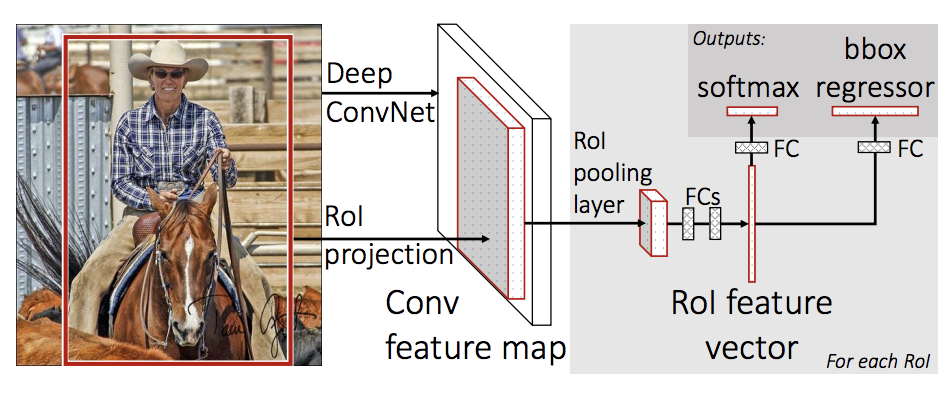
Mask R-CNN adds an extra branch into Faster R-CNN, which also predicts segmentation masks for each instance.
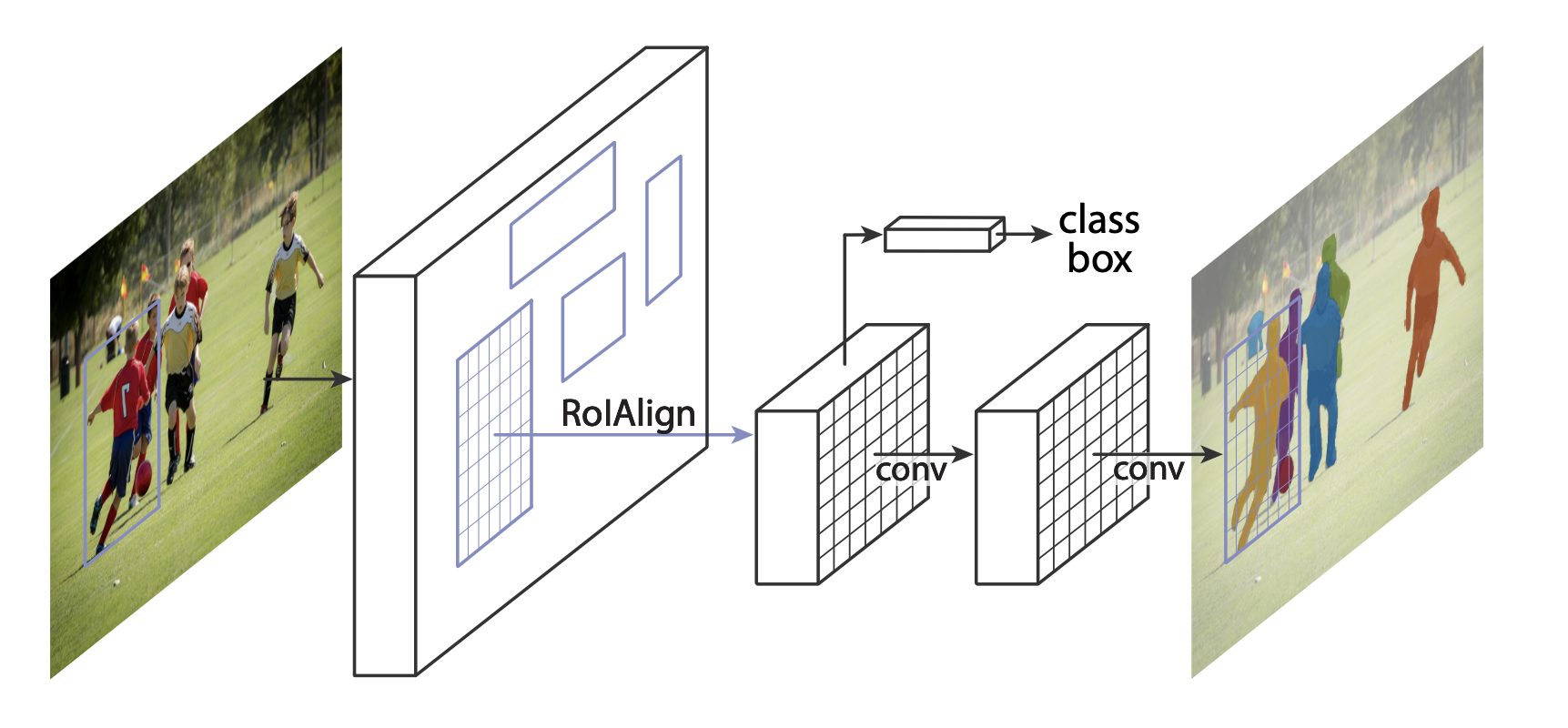
There are two common situations where one might want to modify one of the available models in TorchVision Model Zoo. The first is when we want to start from a pre-trained model, and just finetune the last layer. The other is when we want to replace the backbone of the model with a different one (for faster predictions, for example).
Let’s go see how we would do one or another in the following sections.
1 - Finetuning from a pretrained model¶
Let’s suppose that you want to start from a model pre-trained on COCO and want to finetune it for your particular classes. Here is a possible way of doing it:
import torchvision
from torchvision.models.detection.faster_rcnn import FastRCNNPredictor
# load a model pre-trained on COCO
model = torchvision.models.detection.fasterrcnn_resnet50_fpn(weights="DEFAULT")
# replace the classifier with a new one, that has
# num_classes which is user-defined
num_classes = 2 # 1 class (person) + background
# get number of input features for the classifier
in_features = model.roi_heads.box_predictor.cls_score.in_features
# replace the pre-trained head with a new one
model.roi_heads.box_predictor = FastRCNNPredictor(in_features, num_classes)
2 - Modifying the model to add a different backbone¶
import torchvision
from torchvision.models.detection import FasterRCNN
from torchvision.models.detection.rpn import AnchorGenerator
# load a pre-trained model for classification and return
# only the features
backbone = torchvision.models.mobilenet_v2(weights="DEFAULT").features
# ``FasterRCNN`` needs to know the number of
# output channels in a backbone. For mobilenet_v2, it's 1280
# so we need to add it here
backbone.out_channels = 1280
# let's make the RPN generate 5 x 3 anchors per spatial
# location, with 5 different sizes and 3 different aspect
# ratios. We have a Tuple[Tuple[int]] because each feature
# map could potentially have different sizes and
# aspect ratios
anchor_generator = AnchorGenerator(
sizes=((32, 64, 128, 256, 512),),
aspect_ratios=((0.5, 1.0, 2.0),)
)
# let's define what are the feature maps that we will
# use to perform the region of interest cropping, as well as
# the size of the crop after rescaling.
# if your backbone returns a Tensor, featmap_names is expected to
# be [0]. More generally, the backbone should return an
# ``OrderedDict[Tensor]``, and in ``featmap_names`` you can choose which
# feature maps to use.
roi_pooler = torchvision.ops.MultiScaleRoIAlign(
featmap_names=['0'],
output_size=7,
sampling_ratio=2,
)
# put the pieces together inside a Faster-RCNN model
model = FasterRCNN(
backbone,
num_classes=2,
rpn_anchor_generator=anchor_generator,
box_roi_pool=roi_pooler,
)
Object detection and instance segmentation model for PennFudan Dataset¶
In our case, we want to finetune from a pre-trained model, given that our dataset is very small, so we will be following approach number 1.
Here we want to also compute the instance segmentation masks, so we will be using Mask R-CNN:
import torchvision
from torchvision.models.detection.faster_rcnn import FastRCNNPredictor
from torchvision.models.detection.mask_rcnn import MaskRCNNPredictor
def get_model_instance_segmentation(num_classes):
# load an instance segmentation model pre-trained on COCO
model = torchvision.models.detection.maskrcnn_resnet50_fpn(weights="DEFAULT")
# get number of input features for the classifier
in_features = model.roi_heads.box_predictor.cls_score.in_features
# replace the pre-trained head with a new one
model.roi_heads.box_predictor = FastRCNNPredictor(in_features, num_classes)
# now get the number of input features for the mask classifier
in_features_mask = model.roi_heads.mask_predictor.conv5_mask.in_channels
hidden_layer = 256
# and replace the mask predictor with a new one
model.roi_heads.mask_predictor = MaskRCNNPredictor(
in_features_mask,
hidden_layer,
num_classes,
)
return model
That’s it, this will make model be ready to be trained and evaluated
on your custom dataset.
Putting everything together¶
In references/detection/, we have a number of helper functions to
simplify training and evaluating detection models. Here, we will use
references/detection/engine.py and references/detection/utils.py.
Just download everything under references/detection to your folder and use them here.
On Linux if you have wget, you can download them using below commands:
os.system("wget https://raw.githubusercontent.com/pytorch/vision/main/references/detection/engine.py")
os.system("wget https://raw.githubusercontent.com/pytorch/vision/main/references/detection/utils.py")
os.system("wget https://raw.githubusercontent.com/pytorch/vision/main/references/detection/coco_utils.py")
os.system("wget https://raw.githubusercontent.com/pytorch/vision/main/references/detection/coco_eval.py")
os.system("wget https://raw.githubusercontent.com/pytorch/vision/main/references/detection/transforms.py")
Since v0.15.0 torchvision provides new Transforms API to easily write data augmentation pipelines for Object Detection and Segmentation tasks.
Let’s write some helper functions for data augmentation / transformation:
from torchvision.transforms import v2 as T
def get_transform(train):
transforms = []
if train:
transforms.append(T.RandomHorizontalFlip(0.5))
transforms.append(T.ToDtype(torch.float, scale=True))
transforms.append(T.ToPureTensor())
return T.Compose(transforms)
Testing forward() method (Optional)¶
Before iterating over the dataset, it’s good to see what the model expects during training and inference time on sample data.
import utils
model = torchvision.models.detection.fasterrcnn_resnet50_fpn(weights="DEFAULT")
dataset = PennFudanDataset('data/PennFudanPed', get_transform(train=True))
data_loader = torch.utils.data.DataLoader(
dataset,
batch_size=2,
shuffle=True,
num_workers=4,
collate_fn=utils.collate_fn
)
# For Training
images, targets = next(iter(data_loader))
images = list(image for image in images)
targets = [{k: v for k, v in t.items()} for t in targets]
output = model(images, targets) # Returns losses and detections
print(output)
# For inference
model.eval()
x = [torch.rand(3, 300, 400), torch.rand(3, 500, 400)]
predictions = model(x) # Returns predictions
print(predictions[0])
{'loss_classifier': tensor(0.0820, grad_fn=<NllLossBackward0>), 'loss_box_reg': tensor(0.0278, grad_fn=<DivBackward0>), 'loss_objectness': tensor(0.0027, grad_fn=<BinaryCrossEntropyWithLogitsBackward0>), 'loss_rpn_box_reg': tensor(0.0036, grad_fn=<DivBackward0>)}
{'boxes': tensor([], size=(0, 4), grad_fn=<StackBackward0>), 'labels': tensor([], dtype=torch.int64), 'scores': tensor([], grad_fn=<IndexBackward0>)}
Let’s now write the main function which performs the training and the validation:
from engine import train_one_epoch, evaluate
# train on the GPU or on the CPU, if a GPU is not available
device = torch.device('cuda') if torch.cuda.is_available() else torch.device('cpu')
# our dataset has two classes only - background and person
num_classes = 2
# use our dataset and defined transformations
dataset = PennFudanDataset('data/PennFudanPed', get_transform(train=True))
dataset_test = PennFudanDataset('data/PennFudanPed', get_transform(train=False))
# split the dataset in train and test set
indices = torch.randperm(len(dataset)).tolist()
dataset = torch.utils.data.Subset(dataset, indices[:-50])
dataset_test = torch.utils.data.Subset(dataset_test, indices[-50:])
# define training and validation data loaders
data_loader = torch.utils.data.DataLoader(
dataset,
batch_size=2,
shuffle=True,
num_workers=4,
collate_fn=utils.collate_fn
)
data_loader_test = torch.utils.data.DataLoader(
dataset_test,
batch_size=1,
shuffle=False,
num_workers=4,
collate_fn=utils.collate_fn
)
# get the model using our helper function
model = get_model_instance_segmentation(num_classes)
# move model to the right device
model.to(device)
# construct an optimizer
params = [p for p in model.parameters() if p.requires_grad]
optimizer = torch.optim.SGD(
params,
lr=0.005,
momentum=0.9,
weight_decay=0.0005
)
# and a learning rate scheduler
lr_scheduler = torch.optim.lr_scheduler.StepLR(
optimizer,
step_size=3,
gamma=0.1
)
# let's train it for 5 epochs
num_epochs = 5
for epoch in range(num_epochs):
# train for one epoch, printing every 10 iterations
train_one_epoch(model, optimizer, data_loader, device, epoch, print_freq=10)
# update the learning rate
lr_scheduler.step()
# evaluate on the test dataset
evaluate(model, data_loader_test, device=device)
print("That's it!")
Epoch: [0] [ 0/60] eta: 0:02:43 lr: 0.000090 loss: 2.8181 (2.8181) loss_classifier: 0.5218 (0.5218) loss_box_reg: 0.1272 (0.1272) loss_mask: 2.1324 (2.1324) loss_objectness: 0.0346 (0.0346) loss_rpn_box_reg: 0.0022 (0.0022) time: 2.7332 data: 0.4483 max mem: 1984
Epoch: [0] [10/60] eta: 0:00:24 lr: 0.000936 loss: 1.3190 (1.6752) loss_classifier: 0.4611 (0.4213) loss_box_reg: 0.2928 (0.3031) loss_mask: 0.6962 (0.9183) loss_objectness: 0.0238 (0.0253) loss_rpn_box_reg: 0.0074 (0.0072) time: 0.4944 data: 0.0439 max mem: 2762
Epoch: [0] [20/60] eta: 0:00:13 lr: 0.001783 loss: 0.9419 (1.2621) loss_classifier: 0.2171 (0.3037) loss_box_reg: 0.2906 (0.3064) loss_mask: 0.4174 (0.6243) loss_objectness: 0.0190 (0.0210) loss_rpn_box_reg: 0.0059 (0.0068) time: 0.2108 data: 0.0042 max mem: 2823
Epoch: [0] [30/60] eta: 0:00:08 lr: 0.002629 loss: 0.6349 (1.0344) loss_classifier: 0.1184 (0.2339) loss_box_reg: 0.2706 (0.2873) loss_mask: 0.2276 (0.4897) loss_objectness: 0.0065 (0.0168) loss_rpn_box_reg: 0.0059 (0.0067) time: 0.1650 data: 0.0051 max mem: 2823
Epoch: [0] [40/60] eta: 0:00:05 lr: 0.003476 loss: 0.4631 (0.8771) loss_classifier: 0.0650 (0.1884) loss_box_reg: 0.1924 (0.2604) loss_mask: 0.1734 (0.4084) loss_objectness: 0.0029 (0.0135) loss_rpn_box_reg: 0.0051 (0.0063) time: 0.1760 data: 0.0052 max mem: 2823
Epoch: [0] [50/60] eta: 0:00:02 lr: 0.004323 loss: 0.3261 (0.7754) loss_classifier: 0.0368 (0.1606) loss_box_reg: 0.1424 (0.2366) loss_mask: 0.1479 (0.3599) loss_objectness: 0.0022 (0.0116) loss_rpn_box_reg: 0.0051 (0.0067) time: 0.1775 data: 0.0052 max mem: 2823
Epoch: [0] [59/60] eta: 0:00:00 lr: 0.005000 loss: 0.3261 (0.7075) loss_classifier: 0.0415 (0.1433) loss_box_reg: 0.1114 (0.2157) loss_mask: 0.1573 (0.3316) loss_objectness: 0.0020 (0.0103) loss_rpn_box_reg: 0.0052 (0.0066) time: 0.2064 data: 0.0049 max mem: 2823
Epoch: [0] Total time: 0:00:14 (0.2412 s / it)
creating index...
index created!
Test: [ 0/50] eta: 0:00:25 model_time: 0.1576 (0.1576) evaluator_time: 0.0029 (0.0029) time: 0.5063 data: 0.3452 max mem: 2823
Test: [49/50] eta: 0:00:00 model_time: 0.0335 (0.0701) evaluator_time: 0.0025 (0.0038) time: 0.0594 data: 0.0025 max mem: 2823
Test: Total time: 0:00:04 (0.0862 s / it)
Averaged stats: model_time: 0.0335 (0.0701) evaluator_time: 0.0025 (0.0038)
Accumulating evaluation results...
DONE (t=0.01s).
Accumulating evaluation results...
DONE (t=0.01s).
IoU metric: bbox
Average Precision (AP) @[ IoU=0.50:0.95 | area= all | maxDets=100 ] = 0.722
Average Precision (AP) @[ IoU=0.50 | area= all | maxDets=100 ] = 0.987
Average Precision (AP) @[ IoU=0.75 | area= all | maxDets=100 ] = 0.938
Average Precision (AP) @[ IoU=0.50:0.95 | area= small | maxDets=100 ] = 0.359
Average Precision (AP) @[ IoU=0.50:0.95 | area=medium | maxDets=100 ] = 0.752
Average Precision (AP) @[ IoU=0.50:0.95 | area= large | maxDets=100 ] = 0.730
Average Recall (AR) @[ IoU=0.50:0.95 | area= all | maxDets= 1 ] = 0.353
Average Recall (AR) @[ IoU=0.50:0.95 | area= all | maxDets= 10 ] = 0.762
Average Recall (AR) @[ IoU=0.50:0.95 | area= all | maxDets=100 ] = 0.762
Average Recall (AR) @[ IoU=0.50:0.95 | area= small | maxDets=100 ] = 0.500
Average Recall (AR) @[ IoU=0.50:0.95 | area=medium | maxDets=100 ] = 0.775
Average Recall (AR) @[ IoU=0.50:0.95 | area= large | maxDets=100 ] = 0.769
IoU metric: segm
Average Precision (AP) @[ IoU=0.50:0.95 | area= all | maxDets=100 ] = 0.726
Average Precision (AP) @[ IoU=0.50 | area= all | maxDets=100 ] = 0.993
Average Precision (AP) @[ IoU=0.75 | area= all | maxDets=100 ] = 0.913
Average Precision (AP) @[ IoU=0.50:0.95 | area= small | maxDets=100 ] = 0.344
Average Precision (AP) @[ IoU=0.50:0.95 | area=medium | maxDets=100 ] = 0.593
Average Precision (AP) @[ IoU=0.50:0.95 | area= large | maxDets=100 ] = 0.743
Average Recall (AR) @[ IoU=0.50:0.95 | area= all | maxDets= 1 ] = 0.360
Average Recall (AR) @[ IoU=0.50:0.95 | area= all | maxDets= 10 ] = 0.760
Average Recall (AR) @[ IoU=0.50:0.95 | area= all | maxDets=100 ] = 0.760
Average Recall (AR) @[ IoU=0.50:0.95 | area= small | maxDets=100 ] = 0.633
Average Recall (AR) @[ IoU=0.50:0.95 | area=medium | maxDets=100 ] = 0.662
Average Recall (AR) @[ IoU=0.50:0.95 | area= large | maxDets=100 ] = 0.772
...
Epoch: [4] [ 0/60] eta: 0:00:32 lr: 0.000500 loss: 0.1593 (0.1593) loss_classifier: 0.0194 (0.0194) loss_box_reg: 0.0272 (0.0272) loss_mask: 0.1046 (0.1046) loss_objectness: 0.0044 (0.0044) loss_rpn_box_reg: 0.0037 (0.0037) time: 0.5369 data: 0.3801 max mem: 3064
Epoch: [4] [10/60] eta: 0:00:10 lr: 0.000500 loss: 0.1609 (0.1870) loss_classifier: 0.0194 (0.0236) loss_box_reg: 0.0272 (0.0383) loss_mask: 0.1140 (0.1190) loss_objectness: 0.0005 (0.0023) loss_rpn_box_reg: 0.0029 (0.0037) time: 0.2016 data: 0.0378 max mem: 3064
Epoch: [4] [20/60] eta: 0:00:08 lr: 0.000500 loss: 0.1652 (0.1826) loss_classifier: 0.0224 (0.0242) loss_box_reg: 0.0286 (0.0374) loss_mask: 0.1075 (0.1165) loss_objectness: 0.0003 (0.0016) loss_rpn_box_reg: 0.0016 (0.0029) time: 0.1866 data: 0.0044 max mem: 3064
Epoch: [4] [30/60] eta: 0:00:06 lr: 0.000500 loss: 0.1676 (0.1884) loss_classifier: 0.0245 (0.0264) loss_box_reg: 0.0286 (0.0401) loss_mask: 0.1075 (0.1175) loss_objectness: 0.0003 (0.0013) loss_rpn_box_reg: 0.0018 (0.0030) time: 0.2106 data: 0.0055 max mem: 3064
Epoch: [4] [40/60] eta: 0:00:03 lr: 0.000500 loss: 0.1726 (0.1884) loss_classifier: 0.0245 (0.0265) loss_box_reg: 0.0283 (0.0394) loss_mask: 0.1187 (0.1184) loss_objectness: 0.0003 (0.0011) loss_rpn_box_reg: 0.0020 (0.0029) time: 0.1897 data: 0.0056 max mem: 3064
Epoch: [4] [50/60] eta: 0:00:01 lr: 0.000500 loss: 0.1910 (0.1938) loss_classifier: 0.0273 (0.0280) loss_box_reg: 0.0414 (0.0418) loss_mask: 0.1177 (0.1198) loss_objectness: 0.0003 (0.0010) loss_rpn_box_reg: 0.0022 (0.0031) time: 0.1623 data: 0.0056 max mem: 3064
Epoch: [4] [59/60] eta: 0:00:00 lr: 0.000500 loss: 0.1732 (0.1888) loss_classifier: 0.0273 (0.0278) loss_box_reg: 0.0327 (0.0405) loss_mask: 0.0993 (0.1165) loss_objectness: 0.0003 (0.0010) loss_rpn_box_reg: 0.0023 (0.0030) time: 0.1732 data: 0.0056 max mem: 3064
Epoch: [4] Total time: 0:00:11 (0.1920 s / it)
creating index...
index created!
Test: [ 0/50] eta: 0:00:21 model_time: 0.0589 (0.0589) evaluator_time: 0.0032 (0.0032) time: 0.4269 data: 0.3641 max mem: 3064
Test: [49/50] eta: 0:00:00 model_time: 0.0515 (0.0521) evaluator_time: 0.0020 (0.0031) time: 0.0579 data: 0.0024 max mem: 3064
Test: Total time: 0:00:03 (0.0679 s / it)
Averaged stats: model_time: 0.0515 (0.0521) evaluator_time: 0.0020 (0.0031)
Accumulating evaluation results...
DONE (t=0.01s).
Accumulating evaluation results...
DONE (t=0.01s).
IoU metric: bbox
Average Precision (AP) @[ IoU=0.50:0.95 | area= all | maxDets=100 ] = 0.846
Average Precision (AP) @[ IoU=0.50 | area= all | maxDets=100 ] = 0.997
Average Precision (AP) @[ IoU=0.75 | area= all | maxDets=100 ] = 0.978
Average Precision (AP) @[ IoU=0.50:0.95 | area= small | maxDets=100 ] = 0.412
Average Precision (AP) @[ IoU=0.50:0.95 | area=medium | maxDets=100 ] = 0.689
Average Precision (AP) @[ IoU=0.50:0.95 | area= large | maxDets=100 ] = 0.864
Average Recall (AR) @[ IoU=0.50:0.95 | area= all | maxDets= 1 ] = 0.417
Average Recall (AR) @[ IoU=0.50:0.95 | area= all | maxDets= 10 ] = 0.876
Average Recall (AR) @[ IoU=0.50:0.95 | area= all | maxDets=100 ] = 0.876
Average Recall (AR) @[ IoU=0.50:0.95 | area= small | maxDets=100 ] = 0.567
Average Recall (AR) @[ IoU=0.50:0.95 | area=medium | maxDets=100 ] = 0.750
Average Recall (AR) @[ IoU=0.50:0.95 | area= large | maxDets=100 ] = 0.896
IoU metric: segm
Average Precision (AP) @[ IoU=0.50:0.95 | area= all | maxDets=100 ] = 0.777
Average Precision (AP) @[ IoU=0.50 | area= all | maxDets=100 ] = 0.997
Average Precision (AP) @[ IoU=0.75 | area= all | maxDets=100 ] = 0.961
Average Precision (AP) @[ IoU=0.50:0.95 | area= small | maxDets=100 ] = 0.424
Average Precision (AP) @[ IoU=0.50:0.95 | area=medium | maxDets=100 ] = 0.631
Average Precision (AP) @[ IoU=0.50:0.95 | area= large | maxDets=100 ] = 0.791
Average Recall (AR) @[ IoU=0.50:0.95 | area= all | maxDets= 1 ] = 0.373
Average Recall (AR) @[ IoU=0.50:0.95 | area= all | maxDets= 10 ] = 0.814
Average Recall (AR) @[ IoU=0.50:0.95 | area= all | maxDets=100 ] = 0.814
Average Recall (AR) @[ IoU=0.50:0.95 | area= small | maxDets=100 ] = 0.633
Average Recall (AR) @[ IoU=0.50:0.95 | area=medium | maxDets=100 ] = 0.713
Average Recall (AR) @[ IoU=0.50:0.95 | area= large | maxDets=100 ] = 0.827
That's it!
So after one epoch of training, we obtain a COCO-style mAP > 50, and a mask mAP of 65.
But what do the predictions look like? Let’s take one image in the dataset and verify
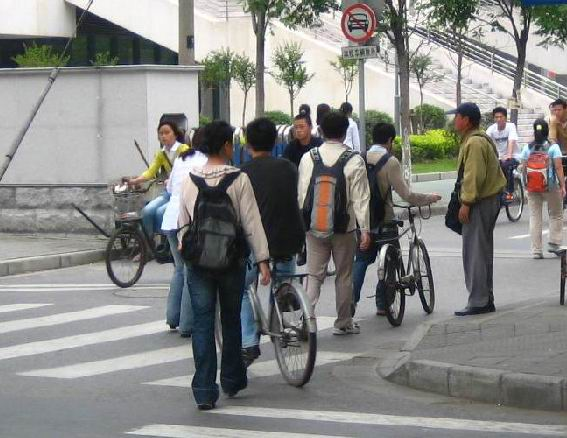
import matplotlib.pyplot as plt
from torchvision.utils import draw_bounding_boxes, draw_segmentation_masks
image = read_image("../_static/img/tv_tutorial/tv_image05.png")
eval_transform = get_transform(train=False)
model.eval()
with torch.no_grad():
x = eval_transform(image)
# convert RGBA -> RGB and move to device
x = x[:3, ...].to(device)
predictions = model([x, ])
pred = predictions[0]
image = (255.0 * (image - image.min()) / (image.max() - image.min())).to(torch.uint8)
image = image[:3, ...]
pred_labels = [f"pedestrian: {score:.3f}" for label, score in zip(pred["labels"], pred["scores"])]
pred_boxes = pred["boxes"].long()
output_image = draw_bounding_boxes(image, pred_boxes, pred_labels, colors="red")
masks = (pred["masks"] > 0.7).squeeze(1)
output_image = draw_segmentation_masks(output_image, masks, alpha=0.5, colors="blue")
plt.figure(figsize=(12, 12))
plt.imshow(output_image.permute(1, 2, 0))
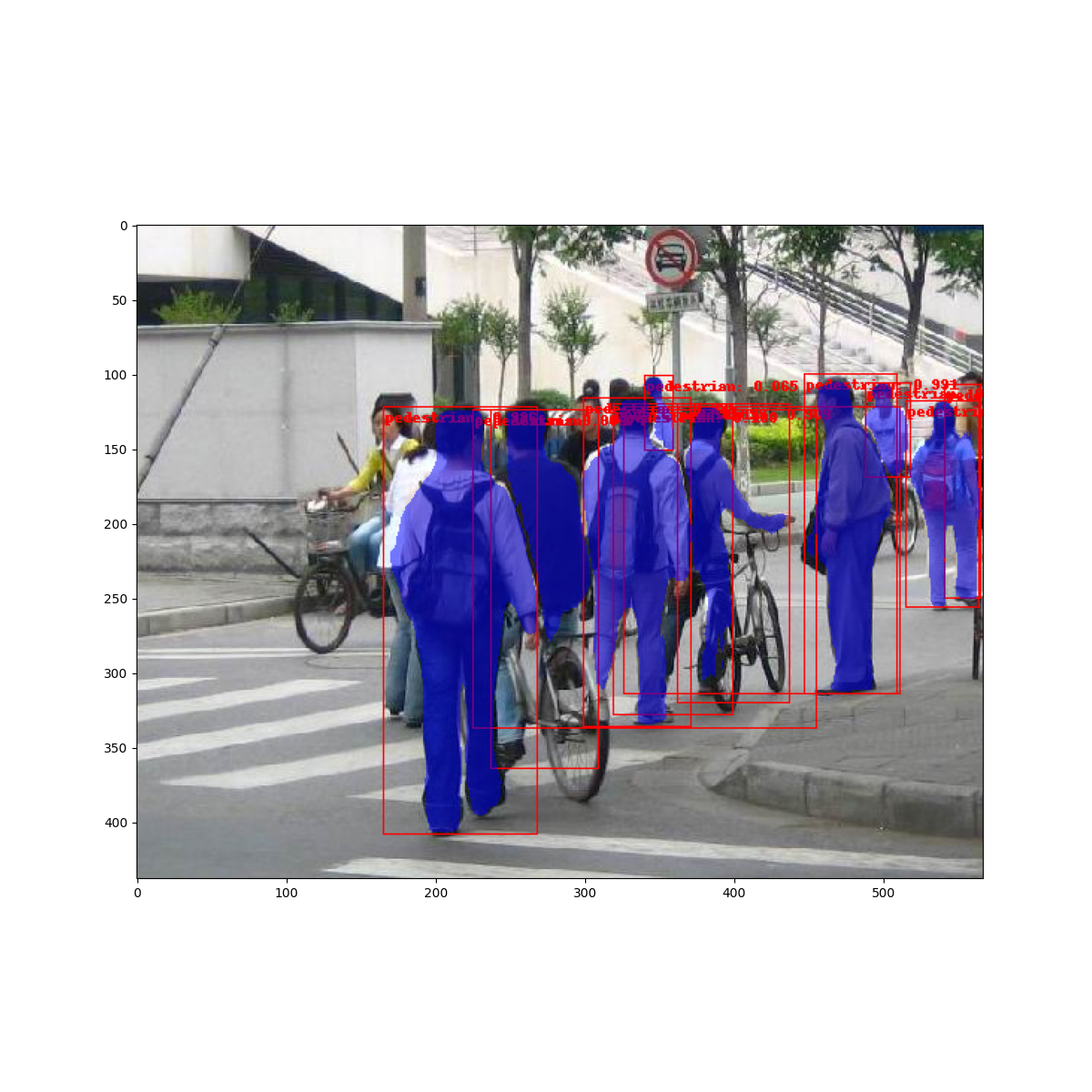
The results look good!
Wrapping up¶
In this tutorial, you have learned how to create your own training
pipeline for object detection models on a custom dataset. For
that, you wrote a torch.utils.data.Dataset class that returns the
images and the ground truth boxes and segmentation masks. You also
leveraged a Mask R-CNN model pre-trained on COCO train2017 in order to
perform transfer learning on this new dataset.
For a more complete example, which includes multi-machine / multi-GPU
training, check references/detection/train.py, which is present in
the torchvision repository.
You can download a full source file for this tutorial here.



